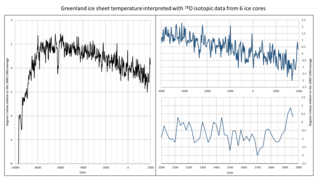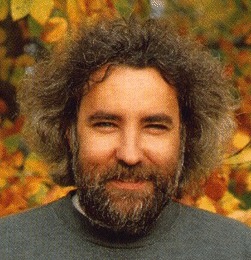Heinz Wanner (born 25 September 1945 in Biel) is a Swiss geographer and climate researcher. He is a professor emeritus and works at the Oeschger Centre for Climate Change Research of the University of Bern.
Contents

Heinz Wanner (born 25 September 1945 in Biel) is a Swiss geographer and climate researcher. He is a professor emeritus and works at the Oeschger Centre for Climate Change Research of the University of Bern.

Wanner studied geography, climatology, geology and mathematics in Bern and Grenoble (France). [1] His supervisors were Bruno Messerli, Max Schüepp and Charles Peguy. He initially worked on synoptic climatology, mesoscale dynamics and mountain meteorology. [2] After completing his doctorate on fog and cold air dynamics over the Swiss Plateau, he worked from 1981 to 1982 at the Department of Atmospheric Science of the Colorado State University in Fort Collins (USA) and as deputy operations director of the international Mountain Experiment ALPEX, which was part of the Global Atmospheric Research Programme (GARP). [2] He then worked on air flows and air pollution in the Alpine region (especially photochemical smog) and chaired the EU working group of the ozone field experiment in Heilbronn-Neckarsulm. [1]
In 1988 he was appointed to a professorship at the University of Bern and was co-director of the Swiss research project POLLUMET (Air POLLUtion and METeorology). [1] [2] Since the beginning of the 1990s, he has been mainly involved in palaeoclimatology and was director of the Swiss National Centre of Competence in Climate Research from 2001 to 2007. He collaborated with Hans Oeschger and Thomas Stocker, with colleagues at ETH Zurich and with European and American research groups. [3] From 2007 until his retirement in 2010, he was the founding president of the Oeschger Centre for Climate Change Research at the University of Bern. [2] His main interest today is in the interrelationships between the Earth's climate dynamics and the development of societies. [3] [4] Wanner has published over 200 scientific articles in specialist journals. [5] His book Climate and Humans. A 12,000-Year History (in German) [6] was published in 2016. In 2021, together with Christian Pfister, he published the comprehensive work Climate and Society in Europe. The Last Thousand Years [7] .
Wanner chaired the Swiss Forum for Climate and Global Change ProClim [8] and was also founding president of the Swiss government's advisory body on climate issues OcCC in 1996. [1] [9] Wanner was involved in the Fourth and Fifth Assessment Reports of the UN Intergovernmental Panel on Climate Change (IPCC). [10] From 2005 to 2010 he also acted as a co-chair of the international Past Global Changes (PAGES) programme. [9]
Heinz Wanner is married to Liliane Kocher since 1975 and is the father of a daughter [11]
In 2006, Heinz Wanner won the Vautrin Lud Prize, the unofficial Nobel Prize for Geography. [9] He is an honorary member of the Swiss Academy of Sciences and a PAGES (Past Global Changes) Fellow, [12] a member of the Leopoldina, [10] received the Medal of Honour from Masaryk University in Brno in 2005 and was awarded the honorary doctorate from Humboldt University in Berlin in 2009 [13]
The Holocene is the current geological epoch. It began approximately 11,700 years before 2000 CE. It follows the Last Glacial Period, which concluded with the Holocene glacial retreat. The Holocene and the preceding Pleistocene together form the Quaternary period. The Holocene has been identified with the current warm period, known as MIS 1. It is considered by some to be an interglacial period within the Pleistocene Epoch, called the Flandrian interglacial.
The Younger Dryas, which occurred circa 12,900 to 11,700 years BP, was a return to glacial conditions which temporarily reversed the gradual climatic warming after the Last Glacial Maximum (LGM), which lasted from circa 27,000 to 20,000 years BP. The Younger Dryas was the last stage of the Pleistocene epoch that spanned from 2,580,000 to 11,700 years BP and it preceded the current, warmer Holocene epoch. The Younger Dryas was the most severe and longest lasting of several interruptions to the warming of the Earth's climate, and it was preceded by the Late Glacial Interstadial, an interval of relative warmth that lasted from 14,670 to 12,900 BP.
The year 1709 in science and technology involved some significant events.

Dansgaard–Oeschger events, named after palaeoclimatologists Willi Dansgaard and Hans Oeschger, are rapid climate fluctuations that occurred 25 times during the last glacial period. Some scientists say that the events occur quasi-periodically with a recurrence time being a multiple of 1,470 years, but this is debated. The comparable climate cyclicity during the Holocene is referred to as Bond events.

The 4.2-kiloyear BP aridification event was one of the most severe climatic events of the Holocene epoch. It defines the beginning of the current Meghalayan age in the Holocene epoch.
Jan Esper studied geography at the University of Bonn, where he later earned his doctorate. After a postdoc position at Columbia University in New York City, he continued his work on dendrochronology at the Swiss Federal Institute for Forest, Snow and Landscape Research (WSL), and qualified as a professor at the University of Bern. In 2018, Esper became a member of the Academy of Sciences and Literature. Since 2010, he has been a professor at the Department of Geography at Johannes Gutenberg University Mainz.

The neoglaciation describes the documented cooling trend in the Earth's climate during the Holocene, following the retreat of the Wisconsin glaciation, the most recent glacial period. Neoglaciation has followed the hypsithermal or Holocene Climatic Optimum, the warmest point in the Earth's climate during the current interglacial stage, excluding the global warming-induced temperature increase starting in the 20th century. The neoglaciation has no well-marked universal beginning: local conditions and ecological inertia affected the onset of detectably cooler conditions.

Bond events are North Atlantic ice rafting events that are tentatively linked to climate fluctuations in the Holocene. Eight such events have been identified. Bond events were previously believed to exhibit a roughly c. 1,500-year cycle, but the primary period of variability is now put at c. 1,000 years.
Teleconnection in atmospheric science refers to climate anomalies being related to each other at large distances. The most emblematic teleconnection is that linking sea-level pressure at Tahiti and Darwin, Australia, which defines the Southern Oscillation. Another well-known teleconnection links the sea-level pressure over Iceland with the one over the Azores, traditionally defining the North Atlantic Oscillation (NAO).

The Great Frost, as it was known in England, or Le Grand Hiver, as it was known in France, was an extraordinarily cold winter in Europe in 1708–1709, and was the coldest European winter during the past 500 years.

Keith Raphael Briffa was a climatologist and deputy director of the Climatic Research Unit. He authored or co-authored over 130 scholarly articles, chapters and books. In his professional work, he focused on climate variability in the late Holocene, with a special focus on northern portions of Europe and Asia. Briffa's preferred method was dendroclimatology, which is a set of procedures intended to decode information about the past climate from tree rings. Briffa helped develop data sets from trees from Canada, Fennoscandia, and northern Siberia which have been used in climate research.

The Oeschger Centre for Climate and Climate Change Research (OCCR) is the interdisciplinary centre of excellence for climate research of the University of Bern.

Lake Tauca is a former lake in the Altiplano of Bolivia. It is also known as Lake Pocoyu for its constituent lakes: Lake Poopó, Salar de Coipasa and Salar de Uyuni. The lake covered large parts of the southern Altiplano between the Eastern Cordillera and the Western Cordillera, covering an estimated 48,000 to 80,000 square kilometres of the basins of present-day Lake Poopó and the Salars of Uyuni, Coipasa and adjacent basins. Water levels varied, possibly reaching 3,800 metres (12,500 ft) in altitude. The lake was saline. The lake received water from Lake Titicaca, but whether this contributed most of Tauca's water or only a small amount is controversial; the quantity was sufficient to influence the local climate and depress the underlying terrain with its weight. Diatoms, plants and animals developed in the lake, sometimes forming reef knolls.
Neopluvial is a term referring to a phase of wetter and colder climate that occurred during the late Holocene in the Western United States. During the Neopluvial, water levels in a number of now-dry lakes and closed lakes such as the Great Salt Lake rose and vegetation changed in response to increased precipitation. The event was not exactly synchronous everywhere, with neopluvial lake-level rises occurring between 6,000 and 2,000 years ago. It is correlative to the Neoglacial period.

Bruno Messerli was a Swiss geographer and university professor who focused on high mountains and highland-lowland linkages. He was appointed Full Professor of Geomorphology in 1968 by the University of Bern, where he taught and carried out research until his retirement in 1996. He contributed significantly to the inclusion of a mountain agenda, Chapter 13 — Managing Fragile Ecosystems — Sustainable Mountain Development in Agenda 21, the official action plan of the United Nations Conference on Environment and Development (UNCED), also known as the Rio de Janeiro Earth Summit, the Rio Summit, the Rio Conference, and the Earth Summit, held in Rio de Janeiro from 3 to 14 June in 1992.

Miscanti Lake (Spanish: Laguna Miscanti) is a brackish water lake located in the altiplano of the Antofagasta Region in northern Chile. Cerro Miñiques volcano and Cerro Miscanti tower over this lake. This 13.5 square kilometres (5.2 sq mi) large heart-shaped lake has a deep blue colour and developed in a basin formed by a fault. South of Miscanti lies Laguna Miñiques, another lake which is separated from Miscanti by a lava flow that was emplaced there during the Pleistocene.

The African humid period is a climate period in Africa during the late Pleistocene and Holocene geologic epochs, when northern Africa was wetter than today. The covering of much of the Sahara desert by grasses, trees and lakes was caused by changes in the Earth’s axial tilt; changes in vegetation and dust in the Sahara which strengthened the African monsoon; and increased greenhouse gases. During the preceding Last Glacial Maximum, the Sahara contained extensive dune fields and was mostly uninhabited. It was much larger than today, and its lakes and rivers such as Lake Victoria and the White Nile were either dry or at low levels. The humid period began about 14,600–14,500 years ago at the end of Heinrich event 1, simultaneously to the Bølling–Allerød warming. Rivers and lakes such as Lake Chad formed or expanded, glaciers grew on Mount Kilimanjaro and the Sahara retreated. Two major dry fluctuations occurred; during the Younger Dryas and the short 8.2 kiloyear event. The African humid period ended 6,000–5,000 years ago during the Piora Oscillation cold period. While some evidence points to an end 5,500 years ago, in the Sahel, Arabia and East Africa, the period appears to have taken place in several steps such as the 4.2-kiloyear event.
Christian Pfister is a Swiss historian.
Sherilyn Fritz is known for her research on paleoclimate and paleoecology, with a particular focus on the use of diatoms to reconstruct past environmental conditions.
The preboreal oscillation (PBO) was a short cooling period within the preboreal stage of the Holocene epoch.
{{cite book}}: CS1 maint: others (link)